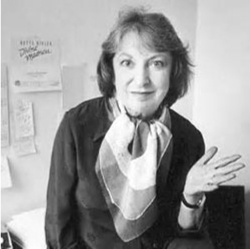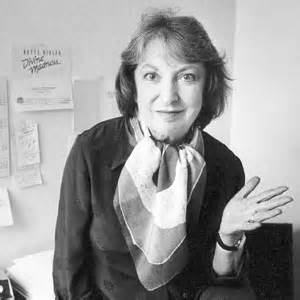
As the lead movie reviewer of The New Yorker between 1968 and 1991, Pauline Kael was arguably the most influential film critic in the United States.
Opinionated, witty, analytical and needling, she believed that film is “the most total and encompassing art form we have,” and that it could feed our imagination in “intimate, immediate, liberating and even subversive ways that literature and plays could not.”
Writing in a brash, colloquial style seemingly at odds with the genteelness of The New Yorker, Kael usually delivered her critiques informally and with a lack of pretension, championing films that had been panned or demolishing films that had been praised.
Kael’s fearlessness and spirit of independence were among the factors that appealed to The New Yorker’s editor, William Shawn, when he hired her to write the column, The Current Cinema, which had been written by Brendan Gill. Looking for a critic who was completely in tune with modern culture and taste, he found one in the person of Kael, whose review of Bonnie and Clyde had impressed him.
This review had originally been commissioned by The New Republic, which had declined to publish it. After Shawn publishing it, she alternated with Penelope Gilliatt as movie critic of The New Yorker.
She was a late bloomer when she joined The New Yorker, says Brian Kellow in Pauline Kael: A Life in the Dark (Viking), a first-rate biography.
As he puts it, “At age 48, her prolonged apprenticeship was finally completed.”
Kael’s gig at The New Yorker, the culmination of what had been a haphazard career, firmly established her in the pantheon of American film critics.
She was probably as famous as James Agee, who had been on the staff of Time from 1941 to 1948 and whom she greatly admired for his ability to dig beneath the surface of a movie.
She discovered her passion for film in Petaluma, California, where she was born on a chicken farm in 1919, the fifth child of Polish Jewish immigrants Isaac and Judith Kael.
The Kaels, having lived in New York City upon their arrival in the United States, settled in Petaluma, a farming community near San Francisco, in 1912. When he lost his farm, Isaac resettled his family in San Francisco and went into the retail poultry and produce business.
Kael was a clever child, learning to read at an early age. She was drawn to movies and particularly liked gritty gangster films and actresses who could unapologetically portray toughness, sexuality and independence.
Enrolling at the University of California at Berkeley in 1936, she majored in philosophy, but dropped out, a few credits short of a degree.
She and her lover, a poet and a journalist, moved to New York City, but the Big Apple did not meet her expectations. She was appalled by the high cost of housing and disappointed by the quality of the people she met in artistic circles. And life was a constant struggle. By day, she was a governess for wealthy family. By night, she wrote short stories and plays.
She returned to San Francisco three years later.
It would be the leanest, most stressful period of her life, Kellow observes. Kael worked at a series of stop-gap, dead-end jobs, and gave birth to a daughter, Gina James, out of wedlock. The father was the filmmaker James Broughton. Since Gina James had health problems, Kael faced a crippling mountain of medical bills.
Kael’s lucky break, the stuff of a Hollywood tearjerker, came in 1952, when the editor of a newly launched magazine, City Lights, overheard her expressing her articulate opinions of Charlie Chaplin’s Limelight in a coffee shop and promptly asked her to review it.
She continued to write for this local publication while broadcasting her reviews on Berkeley’s KPFA-FM, the first listener-supported radio station in the United States.
One of her loyal listeners, Edward Landberg, was the owner of the Berkeley Cinema Guild, which claimed to be one of the first art theatres in the country. She managed his theatre from 1955 to 1960 and wrote capsule reviews of its films. She and Landberg were married, but the marriage, her first and only one, did not endure.
Kael also wrote for small publications like The Partisan Review and Film Quarterly, but her campaign to land a position on a daily newspaper came to naught.
She had better luck when a publishing house offered to publish her reviews in book form. I Lost It at the Movies was a best-seller. Reviewing it in the New York Times, Richard Schickel hailed Kael as “the sanest, saltiest, most resourceful … movie critic … in the United States.”
McCall’s magazine, in 1966, offered her what she most craved: a steady film reviewing job. She was fired shortly afterward, the editor having grown tired of her tendency to pan commercial films such as Lawrence of Arabia and Dr. Zhivago.
She signed on with The New Republic, but quit following a number if disputes.
Kale’s tenure at The New Yorker was rocky as well. Early on, much to her despair, she discovered that her copy was been heavily edited.
Kellow writes: “She had worked hard to develop a spontaneous, intimate, conversational tone, but after it had been through the cleansing process, it didn’t sound so very different from many other articles.”
She felt betrayed because Shawn had promised her that he would not change her copy without permission. They reached an understanding, but Kael continued to upset him with her sexual and scatological language.
Yet, as Kellow points out, Kael was fortunate to be a member of The New Yorker family. Although her salary was hardly grand by Manhattan standards, she was permitted to write in her own true voice and was not saddled by space restrictions.
Although she maintained a “neutral and detached attitude” toward her Jewish identity, Kael liked Fiddler on the Roof. But she was less than impressed by Claude Lanzmann’s epic-length documentary on the Holocaust, Shoah, which struck her as highly self-conscious and arty.
Kael’s ill-conceived decision to leave her perch at The New Yorker to be a consultant for Paramount Pictures is described in voluminous detail. According to Kellow, she was lured to Hollywood by the opportunity to influence studio moguls and feather her nest egg. But she was bitterly disillusioned and left Los Angeles within a few months.
Shawn, at first, was reluctant to rehire her, but once she was back, she got what she had always wanted, a column all to herself. However, Kael’s relationship with Shawn could be testy. Occasionally, he objected to her choice of racy words in reviews.
Kael contracted Parkinson’s disease in 1989, an ailment that affected her memory. With her health in decline, she resigned. Her final piece, a review of Steve Martin’s comedy L.A. Story, appeared in the Feb. 11, 1991 edition. She died on Sept. 3, 2001.
Kellow’s appraisal of Kael’s contribution is succinctly poetic: “She brought us into the experience of sitting next to her in a darkened movie theatre.”
The critic Sanford Schwartz has assembled her thoughtful reviews in a useful companion volume, The Age of Movies: Selected Writings of Pauline Kael (Penguin).
This is a book to savour, appreciate and enjoy, much like Kael’s reviews.
